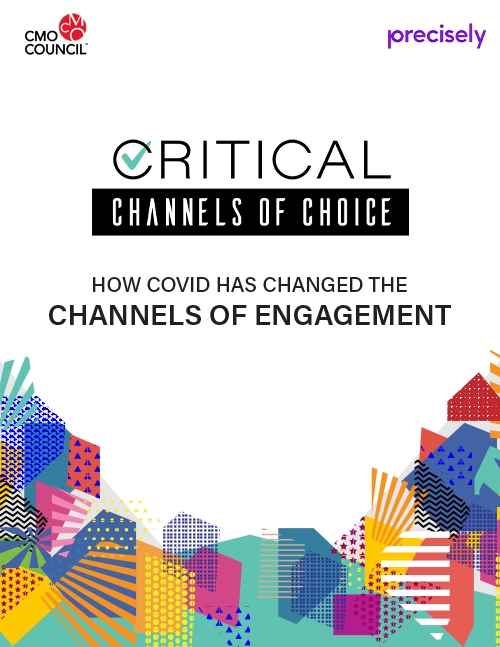The Big Book of Chat Commerce 2025
Get new insights on delivering a friction-free, instantly gratifying customer experience, how to tap into its tremendous potential to build a new customer engagement architecture with chat commerce. More
Exploring How the Live Mobile Chat Commerce Revolution is Powering Fast, Frictionless Transactions, Secure, Lower Cost Customer Engagement, and Stronger Brand Affinity
An exciting digital channel of engagement known as “Chat Commerce” has become a global revolution growing by leaps and bounds — and marketers better jump on board. Chat Commerce has the potential to transform the marketer from a product pusher to a personal concierge who nurtures customer relationships and grows customer lifetime value (LTV).
The CMO Council has identified Chat Commerce as the next big opportunity for marketers, especially in B2C market sectors. This new online resource center will curate all relevant content, research studies, facts and stats, best practices, use cases, vendor profiles, as well trends in adoption and use of Chat Commerce strategies, innovations, solutions and services.
Chat commerce consists of instant and frictionless customer interactions with a brand’s chatbot or live agent conducted mostly over popular mobile messaging platforms. These include Facebook Messenger, WhatsApp, Snapchat, iMessage, WeChat, QQ, Telegram and others, which together have more than 7.5 billion unique active users. Chat Commerce is mobile in nature and does not include conversational chatbots on websites.
Chat Commerce -- with its ability to leverage trusted social connections and engage localized audiences seeking to satisfy real-life needs -- can also uncork a huge and unmapped interactive commerce market for C2C trading. This can easily eclipse and reshape the traditional merchant-driven e-commerce model by introducing simplified mobile payment methods for goods, services, time, talent, technical help and on-demand assistance on a person-to-person or person-to-expert level.
Despite having “commerce” in its name, Chat Commerce goes well beyond interactions that directly convert sales. Rather, interactions span the customer journey, from discovering products and placing orders to making payments and tracking deliveries to resolving issues and providing feedback.
A hallmark characteristic of Chat Commerce is that every brand message instantly and efficiently addresses a consumer’s pressing need — that is, the message is helpful in some way. This makes Chat Commerce a critical piece of CX, as helpful interaction after helpful interaction leads to a lasting customer relationship.
No other channel of engagement has this kind of relevant and repeatable impact.
Market Opportunity
The market opportunity for Chat Commerce is virtually unlimited, and brands have only begun to tap into its potential. Consider only the conversion transaction: Statista reported that the global share of mobile commerce in e-commerce has increased to 72.9%, and mobile commerce is set to reach $3.56 trillion this year. Nearly half of the world’s population owns a smartphone, and eight out of 10 have made a purchase using their smartphone in the last six months.
The Chat Commerce revolution has been driven in large part by the massive spike in adoption of popular chat platforms. Today’s power consumers — Millennials and digital natives — prefer interacting over mobile chat apps than over traditional digital engagement channels. More than 20 billion messages are exchanged between businesses and users monthly on Facebook Messenger. As of July this year, two billion users were accessing the WhatsApp messenger every monthly, according to Statista.
Studies show mobile chat commerce delivering real results for brands. Aberdeen Research recently published a report, “Maximize the ROI of Chat in Commerce Activities,” which found that companies that include chat experience realize 75% year-over-year growth in annual revenue and 89% annual growth in cross-selling and up-selling revenue.
There’s an even bigger payoff for marketers who successfully execute a Chat Commerce strategy. Customer data gleaned from chat interactions will help marketers better understand customers and improve marketing activities. These learnings can also inform future chat interactions so that they become even more helpful.
By now, the great takeaway should be obvious to everyone: Chief marketers and CX leaders need to put Chat Commerce squarely in their sights. By doing so, marketers can harness the power of one-to-one customer interactions, fulfill the promise of a rich and repeatable CX, and nurture relationships that will lead to revenue growth both today and tomorrow.
Value Proposition
Chat Commerce flips the script on marketing, whereby marketers handle inbound requests and help customers solve immediate problems rather than sending outbound promotional offers. It’s like adding lubricant to commerce, enabling frictionless customer engagement.
In a way, inquiry-driven marketing over Chat Commerce is what customer service should have been without the frustration. With Chat Commerce, there are no phone trees to get caught up in, no email to filter through, no waiting hours or days for a resolution. Instead, mobile chat turns irritation into helpful conversation.
Chat Commerce can also be outbound messages, as long as marketers provide utilitarian information, alerts, advisories, confirmations, notifications (e.g., flight change information) or identify verification (e.g., in-chat authentication). Again, Chat Commerce should always be about being helpful, thus making every interaction a successful one. This will lead to stronger brand affinity, not to mention repeat business.
For marketers who do it right, Chat Commerce helps solve one of their biggest challenges: connecting marketing activities to financial outcomes measured by LTV. Often misunderstood and poorly calculated, LTV is nevertheless an important marketing metric that predicts revenue attributed to the future relationship with a customer.
Chat Commerce Outlook
While Chat Commerce is still in early days of adoption, everyone from tech vendors to app builders to big brands are beginning to take action.
Getting into the Chat Commerce game is a lot easier than marketers might think. Brands won’t have to build an app, get it on people’s smartphones, and convince customers to use it. Messaging apps such as WhatsApp have already done the heavy lifting, and consumers are in a comfort zone with them. All marketers have to do is create the awareness.
Down the road, brands can add data science/AI/machine learning to improve responses. After all, Chat Commerce produces valuable behavioral data to learn on. It’s not a stretch to envision hyper-personalized, predictive outbound marketing coming to Chat Commerce when a brand can anticipate a customer’s problem and proactively solve it.
The bottom line: Chat Commerce predisposes and prompts customers to engage, assess, consider, decide, react, and grow value across a lifetime continuum of purchase and relationship dependency. In turn, marketers gain a better understanding of their customers.

Consumers across generations and geographies are moving to digital channels, and running into all sorts of problems. Now 73% of frustrated consumers are considering spending their dollars elsewhere. Brands need to get ahead of this before it’s ... More

Large, global eCommerce communities are disrupting the retail marketplace by bringing together vast numbers of buyers and sellers in frictionless transactional environments. Inspired by their success, brand marketers are rethinking go-to-market strat ... More